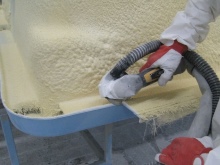All about fiberglass sheet

Due to its strong composition, optimal density and at the same time elasticity, fiberglass received another name - "light metal". It is a popular material that is used in virtually every industry in existence.
Description and scope
Fiberglass is a composite sheet material with the strength of metal and the ability to conduct heat inherent in natural wood. Its composition includes a binder component - a polyester, polycondensation compound and a filler, which is used as a recyclable material (cullet).


Depending on the filler - glass fibers, the product is smooth, as well as coarse or fine wavy. Fiberglass sheet has important physical and chemical characteristics, which are the determining factors for its operation:
- lightness - the material has a low specific gravity;
- high mechanical strength;
- unlimited colors;
- ability to scatter light;
- waterproof - the composition does not absorb moisture;
- resistance to rust, rot, bacteria, organic decomposition, deformation;
- wide temperature range (from -50 to +50 degrees), at which it can be used without fear of violation of useful properties and destruction;
- fiberglass sheets are not subject to the negative effects of sunlight and burnout;
- lack of susceptibility to aggressive chemicals, including salts, alkalis and acids;
- good dielectric qualities;
- the ability of the material to self-cleaning;
- resistance to physical stress, the absence of damage such as chips;
- the monolithic structure of the sheets makes it possible to retain dye particles, therefore, it is possible to apply an ornament on fiberglass materials.


The disadvantage of fiberglass sheet is considered to be the loss of strength during operation, deformation during bending due to low elasticity, vulnerability to the effects of abrasives, a decrease in strength, the formation of harmful dust during processing. For different types of products that are planned to be made of fiberglass, various fillers are taken - woven nets, canvases, mats and ribbons, bundles, cords and other twisted products.
Applications of this material:
- Automotive industry;
- creation of parts for electrical devices;
- manufacture of electrical tools and appliances;
- construction of ships, aircraft, space technology;
- in the oil and gas industry, SPMs are used for the manufacture of tanks, tanks, and other containers for storing and transporting these products.


Besides, fiberglass sheets are a popular material for the insulation of vans, the production of special tanks that transport food... Due to its low thermal conductivity, SPMs are often used for thermal insulation in the construction industry. The material is in demand in the production of outdoor advertising elements, household appliances, interior items.
However, this material is especially relevant for the production of various household products, such as microwave ovens, washing machines, basins, vases, toys, handicrafts, chairs, stationery.


Views
Fiberglass sheets are manufactured in 3 versions.
- In the form of fibroton Is a transparent, tinted material, which is usually used for decorative purposes, since it is produced in a wide color palette.
- In the form of a fiber rover used for cladding and roofing. It is a fiberglass-reinforced polyester made in different colors and differs from other types of SPM in that it is opaque.
- Fibrolight has absolute transparency, which transmits light by 92%, that is, almost not inferior to ordinary glass. It is used to make awnings, special panels for daylighting, hangars and a roof for the penetration of natural light into the room, instead of other expensive materials. But, of course, most often fibrolite is used to create greenhouses and greenhouses, since it is not affected by living microorganisms.
Along with smooth types of fiberglass, it is for domestic purposes that a composite profiled sheet with a thickness of 0.8 to 2 mm is often used. The length of such a product can vary from 1000 to 6000 mm.
These materials are both universal and intended specifically for the creation of fences and roofs.



Features of operation
Working with fiberglass involves cutting it, and this requires knowledge of processing methods and the availability of suitable tools.
- Hand cutting will require the use of a tool such as a hacksaw for metal. This option is suitable if you need to process a small fiberglass sheet with a thickness of no more than 2 mm. But this produces a lot of dust, and this is the main disadvantage of the method.
- For processing thin materials, mechanical tools are suitable - a hacksaw blade or a sharpener. The most affordable and simple cutting tool is a clerical knife. You will also need a ruler - at first, several horizontal notches are made along it, then the desired segment should be broken off with the help of pliers. Further processing consists of sanding the edges with an abrasive or fine-grained emery.
- If you need to cut large quantities of sheets, it is better to use a saw blade with three teeth, which are capable of overpowering material up to 10 mm thick.
- Fiberglass sheets of large size 2000 by 1220 mm with a thickness of 5 mm can be quickly cut using a grinder, angle grinder or a special sawing machine.



Whichever tool is used, do not forget that during any work with this material it is important to observe safety measures and be sure to protect the face and respiratory organs with a mask, and eyes with goggles. It is advisable to protect your hands with latex or silicone gloves.
In the next video, you will see the process of making a composite fiberglass sheet.









The comment was sent successfully.